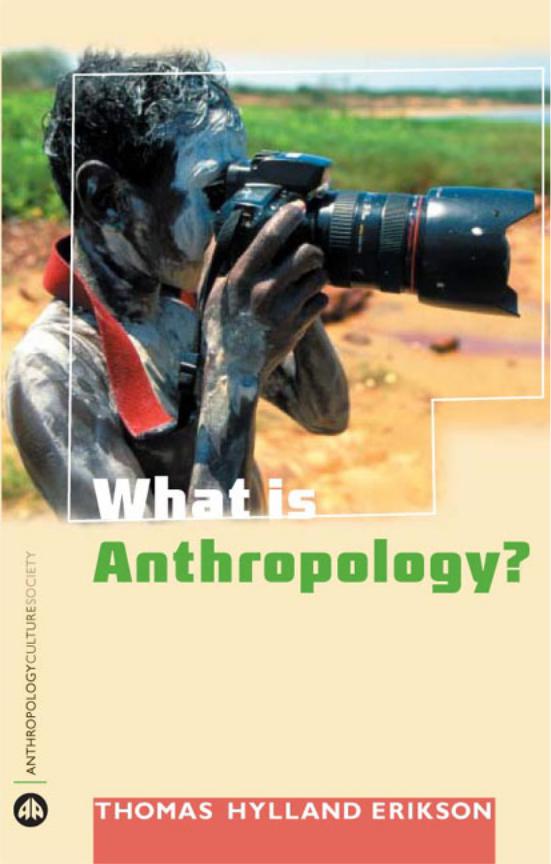
Eriksen T., What Is Anthropology
.pdf

What is Anthropology?
Thomas Hylland Eriksen
Pluto PPress
LONDON • ANN ARBOR, MI

First published 2004 by Pluto Press 345 Archway Road, London N6 5AA and 839 Greene Street,
Ann Arbor MI 48106, USA
www.plutobooks.com
Copyright © Thomas Hylland Eriksen 2004
The right of Thomas Hylland Eriksen to be identified as the author of this work has been asserted by him in accordance with the Copyright, Designs and Patents Act 1988.
British Library Cataloguing in Publication Data
A catalogue record for this book is available from the British Library
ISBN 0 7453 2320 0 hardback
ISBN 0 7453 2319 7 paperback
Library of Congress Cataloging in Publication Data applied for
10 |
9 |
8 |
7 |
6 |
5 |
4 |
3 |
2 |
1 |
Designed and produced for Pluto Press by
Chase Publishing Services, Fortescue, Sidmouth, EX10 9QG, England Typeset from disk by Stanford DTP Services, Northampton, England Printed and bound in the European Union by
Antony Rowe Ltd, Chippenham and Eastbourne, England

‘Make everything as simple as possible. But not simpler.’ (Einstein)
‘He who speaks no foreign language knows nothing about his own.’ (Goethe)

Contents
Part 1 Entrances |
|
|
1 |
Why Anthropology? |
3 |
2 |
The Key Concepts |
19 |
3 |
Fieldwork |
42 |
4 |
Theories |
61 |
Part 2 Fields |
|
|
5 |
Reciprocity |
85 |
6 |
Kinship |
101 |
7 |
Nature |
120 |
8 |
Thought |
140 |
9 |
Identification |
156 |
Bibliography |
171 |
|
Index |
174 |
|

Part 1
Entrances


1
Why Anthropology?
A generation ago, anthropology was scarcely known outside of academic circles. It was a tiny university subject taught in a few dozen countries, seen by outsiders as esoteric and by insiders as a kind of sacred knowledge guarded by a community of devoted initiates. Anthropologists went about their fieldwork in remote areas and returned with fascinating, but often arcane analyses of kinship, slash and burn horticulture or warfare among ‘the others’. With a few spectacular exceptions, the interest in anthropology from the outside world was modest, and its influence was usually limited to academic circles. Only very rarely did it play a part in the public life of the anthropologist’s own society.
This has changed. Growing numbers of non-academics in the West have discovered that anthropology represents certain fundamental insights concerning the human condition, applicable in many everyday situations at home. Its concepts are being borrowed by other university disciplines and applied to new phenomena, its ideas about the need to see human life from below and from the inside have influenced popular journalism, and student numbers have grown steadily, in some places dramatically. For example, at the University of Oslo, the number of anthropology students grew from about 70 in 1982 to more than 600 a decade later.
In many western societies, anthropology and ideas derived from the subject became part of the vocabulary of journalists and policymakers in the 1990s. This is no coincidence. In fact, it can be argued that anthropology is indispensable for understanding the present world, and there is no need to have a strong passion for African kinship or Polynesian gift exchange to appreciate its significance.
There are several reasons why anthropological knowledge can help in making sense of the contemporary world. First, contact between culturally different groups has increased enormously in our time. Long-distance travel has become common, safe and relatively inexpensive. In the nineteenth century, only a small
3

4 Entrances
proportion of the western populations travelled to other countries (emigrants excluded), and as late as the 1950s, even fairly affluent westerners rarely went on holiday abroad. As is well known, this has changed dramatically in recent decades. The flows of people who move temporarily between countries have grown and have led to intensified contact: business-people, aid workers and tourists travel from more economically developed countries to less economically developed ones, and labour migrants, refugees and students move in the opposite direction. Many more westerners visit ‘exotic’ places today than a generation ago. In the 1950s, people may have been able to go on a trip to Rome or London once in their lifetime. In the 1980s, people could travel by Interrail to Portugal and Greece, and take similar trips every summer. Young people with similar backgrounds today might go on holiday to the Far East, Latin America and India. The scope of tourism has also been widened and now includes tailormade trips and a broad range of special interest forms including ‘adventure tourism’ and ‘cultural tourism’, where one can go on guided tours to South African townships, Brazilian favelas or Indonesian villages. The fact that ‘cultural tourism’ has become an important source of income for many communities in the less economically developed world can be seen as an indication of an increased interest in other cultures from the West. It can be a short step from cultural tourism to anthropological studies proper.
At the same time as ‘we’ visit ‘them’ in growing numbers and under new circumstances, the opposite movement also takes place, though not for the same reasons. It is because of the great differences in standards of living and life opportunities between more and less economically developed countries that millions of people from non-western countries have settled in Europe and North America. A generation ago, it might have been necessary for an inhabitant in a western city to travel to the Indian subcontinent in order to savour the fragrances and sounds of subcontinental cuisine and music. Today there are large numbers of Indian restaurants in many western cities, ranging from four-star establishments to inexpensive takeaway holes in the wall. Pieces and fragments of the world’s cultural variation can now be found on the doorstep of westerners. As a result, the curiosity about others has been stimulated, and it has also become necessary for political reasons to understand what cultural

Why Anthropology? 5
variation entails. Current controversies over multicultural issues, such as religious minority rights, the hijab (shawl or headscarf), language instruction in schools and calls for affirmative action because of ethnic discrimination in the labour market testify to an urgent need to deal sensibly with cultural differences.
Second, the world is shrinking in other ways too. Satellite television, cellphone networks and the Internet have created conditions for truly global, instantaneous and friction-free communications. Distance is no longer a decisive hindrance for close contact; new, deterritorialised social networks or even ‘virtual communities’ develop, and at the same time, individuals have a larger palette of information to choose from. Moreover, the economy is also becoming increasingly globally integrated. Transnational companies have grown dramatically in numbers, size and economic importance over the last decades. The capitalist mode of production and monetary economies in general, globally dominant throughout the twentieth century, have become nearly universal. In politics as well, global issues increasingly dominate the agenda. Issues of war and peace, the environment and poverty are all of such a scope, and involve so many transnational linkages, that they cannot be handled satisfactorily by single states alone. AIDS and international terrorism are also transnational problems which can only be understood and addressed through international cooperation. This ever tighter interweaving of formerly relatively separate sociocultural environments can lead to a growing recognition of the fact that we are all in the same boat; that humanity, divided as it is by class, culture, geography and opportunities, is fundamentally one.
Third, culture changes rapidly in our day and age, which is felt nearly everywhere in the world. In the West, typical ways of life are being transformed. The stable nuclear family is no longer the only common and socially acceptable way of life. Youth culture and trends in fashion and music change so fast that older people have difficulties following their twists and turns; food habits are being transformed, leading to greater diversity within many countries, and so on. These and other changes make it necessary to ask questions such as: ‘Who are we really?’, ‘What is our culture, and is it at all meaningful to speak of a “we” that “has” a “culture”?’ ‘What do we have in common with the people who used to live here 50 years ago, and what do we have in common with people
